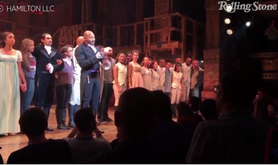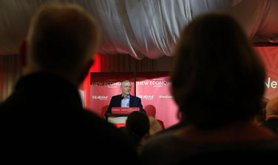
President Erdogan speaks to his supporters, Istanbul, July 16, 2016.Depo/Press Association. All rights reserved.Turkey is set for a tough referendum campaign period as parties take to the stage to persuade the electorate to vote “yes” or “no” for the April 16 referendum about a new presidential system. President Erdoğan also stated that the referendum should be seen as a “response” to the 15 July 2016 coup attempt in Turkey, claiming that “the position of those who will say ‘no’ in the referendum could mean siding with July 15.”
Following this speech, supporters of ‘NO’ accused Erdogan of polarizing the people in Turkey. However, far from being a crime, polarization has become the most important strategy of politics for Erdogan. Erdogan's polarization strategy is shaped by the AKP’s history and how this approach responds to the public.
‘We see him as one of us’
‘The president’s backers often cite three main reasons for his popularity and that of his party, the AKP. The first is social: Erdoğan is perceived to be a man of the people, a representative of the lower and lower-middle classes, who felt ignored by his predecessors. “The thing is, before Erdoğan the presidents didn’t value people,” said a man who called himself Ismail, waving an AKP flag. “But Erdoğan cares about them. That’s the main thing. We see him as one of us.”’
So reported the Guardian following the July 15, 2016, military coup attempt in Turkey. Citizens from the lower classes in Turkey have supported Erdogan because they believe that Erdogan might be their father, brother or close friend. Erdogan honed his discourse and speeches for the lower classes to gain their support and he is very successful in realizing this goal. Crucial to Erdogan’s lower class mythology is the dichotomy of White Turks-Black Turks. White Turk has come to be associated with an urban cosmopolitan identity, modern feminism, secularism, while the Black Turk stands for the traditional, the conservative and lower-classes. One of the columnists, Burak Bekdil claims that Erdogan’s success story is precisely the victory of the Black Turks over the white Turks and illustrates the point with an anecdote about one of ‘Tayyip’s’ supporters;
…I saw one of the crowd of paper-tissue-seller-boys at the scooter's seat, pretending to ride it fast. I had to buy a few packs of paper tissues to convince the boy to leave the seat to me. An initial conversation on motorbikes and scooters quickly turned into a ‘political chat' with my new, nine-year-old friend. ..How much do you earn? It depends. Sometimes 5 lira a day, sometimes even 25! Fine, but you can't sell paper tissues for all of your life. Any plans for the future? Yes, abi; I'll fight infidels like you and join ‘Uncle Tayyip's' party. Infidels like me? Yes, abi, I saw you drinking wine at the café… One day, the boy said, he would become an MP. I wished him the best of luck. What does your father do for living? No job, abi. Any brothers and sisters? We're 12! But what makes you so fond of your ‘Uncle Tayyip?' He is a good Muslim, and he sent us food, toys and other things. Why do you want to become an MP? Because they are rich and powerful, and I can better fight the infidels. Infidels like me? Like you, abi.
Bekdil’s reminiscence regarding this child is necessary to understand Erdogan’s polarization strategy and his popularity among the lower classes. According to some scholars, leaders in authoritarian regimes should redistribute money to keep their supporters and should pay their followers just enough to support them. Interestingly, Bekdil’s anecdote tells a very different story. Although there is an increase of poor people from the lower classes in Turkey, these people have continued to support Erdogan’s leadership. The main reason for this support is the notion of Erdogan’s populist leadership with his lower class metaphors and the perennially useful Black Turks-White Turks dichotomy.
Erdogan uses the term ‘zenci’ (Black Turks) in most of his speeches, and always claims that he is proud to be a zenci like the other lower class citizens in Turkey. Following the AKP’s second term, Erdogan began to treat uneducated people as ‘Black Turks’, like himself. White Turks here are the well-educated, well-to-do Kemalist elites fashioning themselves on (some of) Ataturk’s ideas. They are often associated with state bureaucracy and the military. Black Turks are those who the White Turks despise as low-educated, lower-class and either still peasants in Anatolian or rural areas or unable to shake off their peasant heritage. Following the Gezi Park protests which of course were forced upon Turkey by these elites, the White Turks of Turkish society, he speaks about them as below:
“According to them we don’t understand politics. According to them we don’t understand art, theatre, cinema, poetry. According to them we don’t understand aesthetics, architecture. According to them we are uneducated, ignorant, the lower class, who has to be content with what we are given, needy; meaning, we are a group of negroes.”
Peasants or people who live in Anatolian villages are complete ‘Black Turks’ in Erdogan’s classification because these people were pressurized by Kemalist elites during the early Republican period. ‘White Turks’ or Kemalist elites have always mocked them due to their uneducated/conservative identity. This article gives an example of Erdogan’s mukhtar (local head person in villages) meetings for understanding this phenomenon. Since January 2015, President Recep Tayyip Erdogan has delivered monthly speeches to mukhtars, invited in groups to his presidential palace in Ankara. At the first meeting he said that;
"They were mocking me and all my mukhtar brothers by saying 'He cannot even be a mukhtar'. However, this nation elected me deputy, made me the Prime Minister and then elevated me to the office of Presidency by making me the first directly-elected President of the Republic of Turkey.”
Overall, Erdogan’s lower class mythology helped to consolidate and polarize his voters especially after 2011. Indeed the lower class population is far larger numerically than the upper classes in Turkey, and Erdogan is well aware of this. He has used both conservative and traditionalist discourses addressed to the lower classes in such a way as to maintain the loyalty of a mass electorate. I think the polarizing strategy Erdogan used as a trump card in the last elections will also play a vital role in the April 16 referendum.
Read more
Get our weekly email




Comments
We encourage anyone to comment, please consult the oD commenting guidelines if you have any questions.